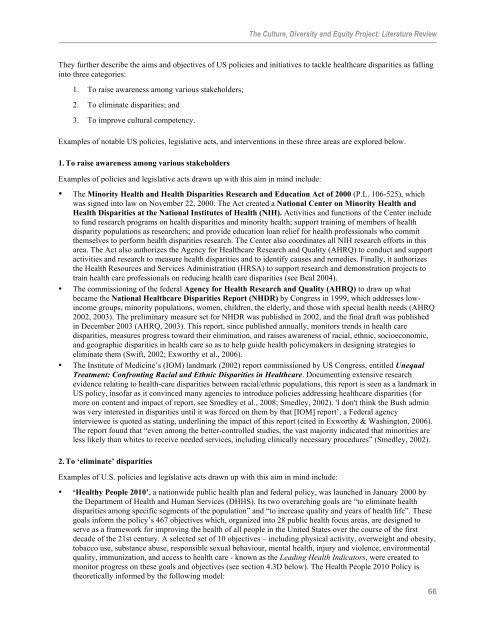CDE Appendix 1 Literature Review - Central East Local Health ...
CDE Appendix 1 Literature Review - Central East Local Health ...
CDE Appendix 1 Literature Review - Central East Local Health ...
You also want an ePaper? Increase the reach of your titles
YUMPU automatically turns print PDFs into web optimized ePapers that Google loves.
The Culture, Diversity and Equity Project: <strong>Literature</strong> <strong>Review</strong><br />
They further describe the aims and objectives of US policies and initiatives to tackle healthcare disparities as falling<br />
into three categories:<br />
1. To raise awareness among various stakeholders;<br />
2. To eliminate disparities; and<br />
3. To improve cultural competency.<br />
Examples of notable US policies, legislative acts, and interventions in these three areas are explored below.<br />
1. To raise awareness among various stakeholders<br />
Examples of policies and legislative acts drawn up with this aim in mind include:<br />
• The Minority <strong>Health</strong> and <strong>Health</strong> Disparities Research and Education Act of 2000 (P.L. 106-525), which<br />
was signed into law on November 22, 2000. The Act created a National Center on Minority <strong>Health</strong> and<br />
<strong>Health</strong> Disparities at the National Institutes of <strong>Health</strong> (NIH). Activities and functions of the Center include<br />
to fund research programs on health disparities and minority health; support training of members of health<br />
disparity populations as researchers; and provide education loan relief for health professionals who commit<br />
themselves to perform health disparities research. The Center also coordinates all NIH research efforts in this<br />
area. The Act also authorizes the Agency for <strong>Health</strong>care Research and Quality (AHRQ) to conduct and support<br />
activities and research to measure health disparities and to identify causes and remedies. Finally, it authorizes<br />
the <strong>Health</strong> Resources and Services Administration (HRSA) to support research and demonstration projects to<br />
train health care professionals on reducing health care disparities (see Beal 2004).<br />
• The commissioning of the federal Agency for <strong>Health</strong> Research and Quality (AHRQ) to draw up what<br />
became the National <strong>Health</strong>care Disparities Report (NHDR) by Congress in 1999, which addresses lowincome<br />
groups, minority populations, women, children, the elderly, and those with special health needs (AHRQ<br />
2002, 2003). The preliminary measure set for NHDR was published in 2002, and the final draft was published<br />
in December 2003 (AHRQ, 2003). This report, since published annually, monitors trends in health care<br />
disparities, measures progress toward their elimination, and raises awareness of racial, ethnic, socioeconomic,<br />
and geographic disparities in health care so as to help guide health policymakers in designing strategies to<br />
eliminate them (Swift, 2002; Exworthy et al., 2006).<br />
• The Institute of Medicine’s (IOM) landmark (2002) report commissioned by US Congress, entitled Unequal<br />
Treatment: Confronting Racial and Ethnic Disparities in <strong>Health</strong>care. Documenting extensive research<br />
evidence relating to health-care disparities between racial/ethnic populations, this report is seen as a landmark in<br />
US policy, insofar as it convinced many agencies to introduce policies addressing healthcare disparities (for<br />
more on content and impact of report, see Smedley et al., 2008; Smedley, 2002). 'I don't think the Bush admin<br />
was very interested in disparities until it was forced on them by that [IOM] report’, a Federal agency<br />
interviewee is quoted as stating, underlining the impact of this report (cited in Exworthy & Washington, 2006).<br />
The report found that “even among the better-controlled studies, the vast majority indicated that minorities are<br />
less likely than whites to receive needed services, including clinically necessary procedures” (Smedley, 2002).<br />
2. To ‘eliminate’ disparities<br />
Examples of U.S. policies and legislative acts drawn up with this aim in mind include:<br />
• ‘<strong>Health</strong>y People 2010’, a nationwide public health plan and federal policy, was launched in January 2000 by<br />
the Department of <strong>Health</strong> and Human Services (DHHS). Its two overarching goals are “to eliminate health<br />
disparities among specific segments of the population” and “to increase quality and years of health life”. These<br />
goals inform the policy’s 467 objectives which, organized into 28 public health focus areas, are designed to<br />
serve as a framework for improving the health of all people in the United States over the course of the first<br />
decade of the 21st century. A selected set of 10 objectives – including physical activity, overweight and obesity,<br />
tobacco use, substance abuse, responsible sexual behaviour, mental health, injury and violence, environmental<br />
quality, immunization, and access to health care - known as the Leading <strong>Health</strong> Indicators, were created to<br />
monitor progress on these goals and objectives (see section 4.3D below). The <strong>Health</strong> People 2010 Policy is<br />
theoretically informed by the following model:<br />
66

















